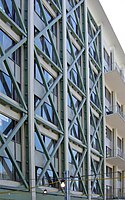
Photo from wikipedia
Based on the seismic isolation design concept of functional separation, a seismic isolation system with bearings and braces combination for railway bridge was proposed. The sliding bearings afford the vertical… Click to show full abstract
Based on the seismic isolation design concept of functional separation, a seismic isolation system with bearings and braces combination for railway bridge was proposed. The sliding bearings afford the vertical loads, and the self-centering energy dissipation brace (SCED) and buckling restrained brace (BRB) control the horizontal displacement of the beam, so the functional separation was achieved under the combined action. Taking a long-span railway continuous beam-arch bridge as an example, the corresponding analysis model was established to study lateral seismic response and the girder’s displacement pattern of the continuous beam-arch bridge under the earthquake excitations. The seismic response of bridges with different seismic isolation schemes was studied. The result showed that the presence of arch rib in a continuous beam-arch bridge amplifies the transverse displacement response of the girder compared with that in a continuous beam bridge of equal mass. The seismic isolation system with sliding bearings and energy dissipation braces can control the relative displacement between the pier and beam greatly, and the SCED can reduce or even eliminate the residual displacement between pier and beam. Furthermore, under the strong ground motions, the combined use of SCED and BRB can achieve the seismic isolation to the maximum extent when the self-centering force ratio ζ, the ratio of self-centering force to superstructure weight, is 0.074.
Journal Title: Shock and Vibration
Year Published: 2020
Link to full text (if available)
Share on Social Media: Sign Up to like & get
recommendations!